How to Write a Press Release for Great Results [Examples + Tips]
- Home
- Intelligent Insights Blog
- How to Write a Press Release for Great Results [Examples + Tips]
Press releases alert the media to important changes to your business. Pretty basic, right?
But the problem arises when you have to sit down and write the thing.
It’s not enough to throw together a document and blast it to journalists. Even if you’ve got a template and get the gist of the formatting.
So, how do you write a press release?
And, more important, how do you write a press release that’s exciting for journalists?
When a single document could make or break your company, it’s worth it to know how to do it right. That’s why we made this guide.
To give you the tools you need to know how to write a press release, get it to the right people, and get the media coverage you need.
Here’s what we’ve included:
- What is a press release? What are the benefits?
- Types of Press Releases
- How to Format a Press Release
- How to Write a Press Release
- What to Do Before Sending a Press Release
- Examples of Well-executed Press Releases
Have an important press release and don’t have time to do it yourself?
Let us do it for you! Book a free consultation with one of our PR experts. We will help you write and submit your press release.
What is a Press Release? Why Should You Bother?
For starters, it’s important to understand what a press release is. The essence of it.
What is a press release?
A press release is a brief, official document that contains newsworthy information about your brand or business. It’s also a formal document with special formatting. It includes a succinct summary of your announcement so journalists know why it matters, why it’s significant, and how it fits into a broader context.
The purpose of a press release is to highlight a big achievement or change in your business that is important for the public to know. And the goal is to get as much media attention as possible.
Here are some examples of different types of press releases:
- Breaking Company News
- New Product, Service, Offer, or Research
- Mergers or Acquisitions
- Product or Tech Updates or Fixes
- Events, Promotions, Contests
- Grand Openings, Expansion, New Business
- New Partnerships
- Rebranding or Website Redesign
- Executive Promotions and Hires
- Important Awards and Nominations
- Crisis or Emergency Communications
- Social Responsibility and Environmental Sustainability Initiatives
Here’s an example of a partnership announcement press release:
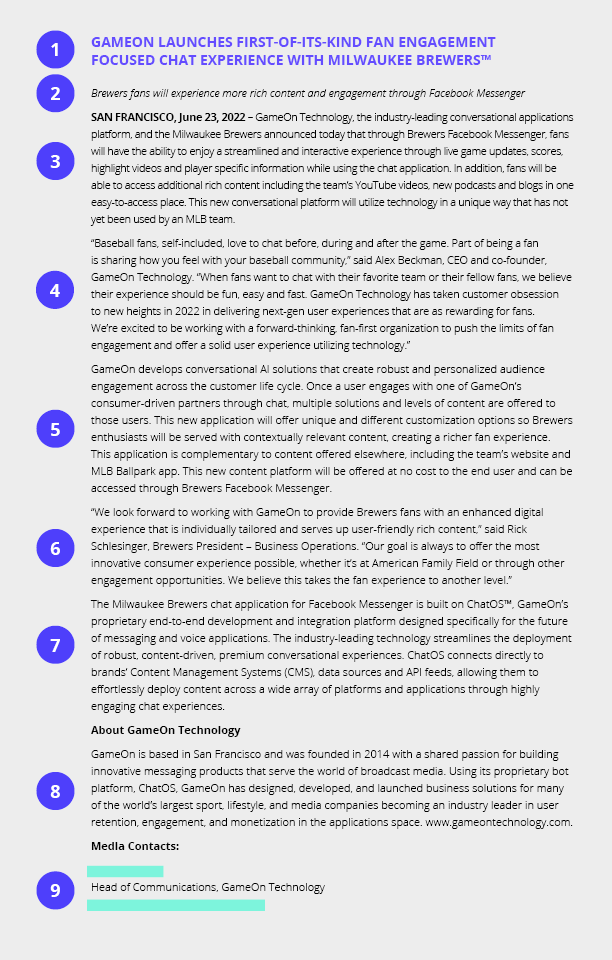
What are the benefits of sending a press release?
Here are a few of the more obvious benefits:
- Attracts cost-effective media attention.
- Generates publicity and brand awareness.
- Allows you to control the narrative of any story.
- Boosts your marketing and SEO efforts.
- Allows you to share positive public perceptions.
- Helps you build important relationships.
To recap, here are the 5 most important takeaways on how to write a press release:
- Your press release should cover something newsworthy.
- Your press release should make journalists excited to write a story about you.
- Your press release should follow a specific format.
- Your press release should promote your brand and tell a controlled narrative.
- Your press release should include all information that a journalist needs to know.
Pro Tip: Is your announcement newsworthy? That’s the most important thing to get right when learning how to write a press release. If you’re a small company, will journalists care if you’ve hired a new CEO? Or would they be more interested in new, exciting research? It’s for you to decide.
If you want a more in-depth read about the nature of press releases, check out our article: What Press Release Are and What They Do
How to Format a Press Release [Example + Tips]
Let’s start with the basics of how to write a press release – formatting.
Because a press release is a formal document, it needs proper formatting. And you can follow a template for that purpose. Just keep in mind that not every press release is created equal.
Design and layouts may differ from one template to the next. How you choose to display your content is up to you. The main rule of thumb is to be sure that you’re including all the key ingredients.
Here’s a list of key elements that you should consider including:
- Contact Info and Date (Top Left/Top Right)
- “For Immediate Release” or “Hold Release Until [Date]” (Top Left/Top Right)
- Clear Headline or Title Announcing Topic
- Subtitle
- Business Location (First Sentence / Bold)
- Pitch (All Important Info) (First Paragraph)
- Body Paragraphs (More Context, Quotes, Data, Media)
- Boilerplate / About Us Company Information (End)
- Sign Off + Contact Information of PR Contact
- ### Symbols Signifying End of Release
Here’s an example of how we format our press releases with the different sections marked:
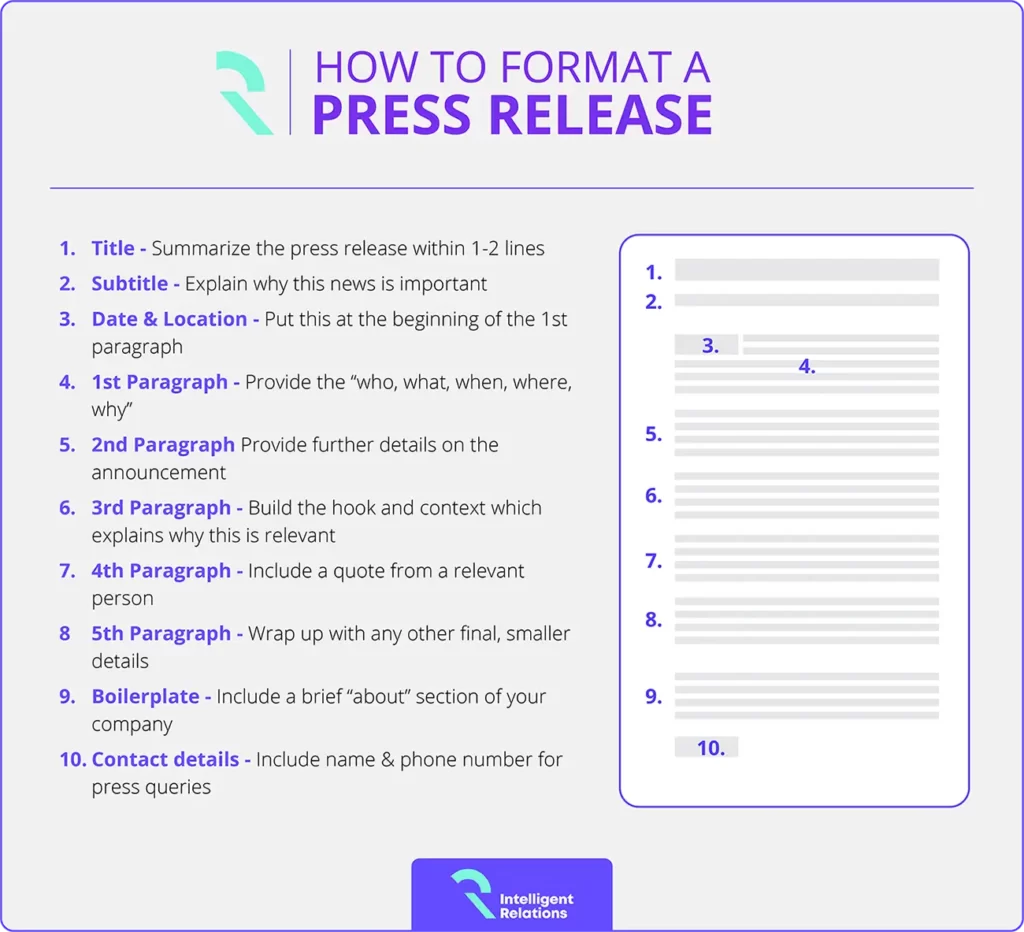
Pro Tip: Look at what similar companies are doing with their press release layouts. You may decide you want to copy their look and feel or go in a different direction. Blend in or stand out, whatever you choose content is the true king. Focus on making your item newsworthy first.
Formatting a press release is like formatting a resume. Catch the reader’s attention while providing all information. For more read: The Must-use Industry Format for Press Releases
How to Write a Press Release [Examples + Tips]
Before you start writing, let’s talk about length. Again, like a resume, press releases are short, one-page documents. Try to not go past one page of copy. Aim for 4-6 short paragraphs. And be sure to place the most important information at the top of the page.
If you must go past one page, be sure to write – more – at the bottom of the page so that journalists know to keep reading.
The body paragraphs should include all important information about the announcement you’re making. Finally, every press release ends with a boilerplate or a brief overview of your company. Follow that up with the contact details of the person who handles your press inquiries.
Now, let’s go into a little more detail about what each paragraph should cover.
How to Write a Press Release Headline and Hook
Your headline is the first thing a journalist is going to read. It needs to be catchy and include the most important points. And you should try to do it in 10 words or less. Your headline should shape both the tone and the angle of the story you’re telling.
Here are some examples of press release headlines:
BAD: New Coffee Business Opens in Colombia
GOOD: New Specialty Coffee Incubator Aims to Put Medellin Coffee Industry on the Map
BAD: Maxifi Announces New Product – Upside Investing
GOOD: Maxifi Announces Upside Investing – Invest While Maintaining a High Living Standard
BAD: MIT Enterprise Forum Cambridge Announces a New Nonprofit Initiative
GOOD: MIT Enterprise Forum Cambridge Launches Tuition-free Program to Help Tech Entrepreneurs of Color Succeed
While some of these are lengthy, all three of the “good” examples do the same thing. They “hook” the reader’s attention by tapping into trending issues and social problems.
The first example taps into the fact that the new company is based in Medellin. Medellin is a city that is reinventing itself, becoming a vibrant business and cultural hub. The new coffee incubator taps into that narrative. It will help build the city’s coffee industry to match other regions.
The second example shows how Maxifi’s new product will provide a solution to a social problem. Lower income people have trouble both investing in stock and maintaining a normal standard of living. Their new product will allow for that.
And the third example also explains how it will provide a solution to a social issue – that of race disparity among entrepreneurs.
It’s important to include a “hook” to get and keep the reader’s attention. In a press release, the hook is the part that builds the reader’s interest and establishes your piece of news as relevant and significant to a wider audience.
If you can connect what you’re promoting to a wider audience, you’ve created a successful hook. As seen in the examples, try tapping into trending issues, social problems, or current events.
Take a look at this press release from H&M as another example:
“New brand H&M Move, launching worldwide August 4th, is embarking on a bold mission to democratize sportswear and get the whole world and everybody moving, however they move. H&M Move aims to equip the world with stylish and functional ‘movewear’ that will support Movers of all abilities and skills to move comfortably and confidently.”
The hook here is that H&M is tapping into the trending issue of body positivity. Yes, the brand was designed as a way to address that particular social problem. At the same time, the press release emphasizes the point and sets the tone with specific language.
Instead of “sportswear” you have the more inclusive “movewear.” They aren’t simply launching their new brand H&M Move worldwide on August 4th. It’s so much more than that. It’s a hook.
How to Write a Press Release’s All Important First Paragraph
Once you’ve caught their attention, the next step of learning how to write a press release is to make sure they have all the most important details. So, your first paragraph should contain the 5 W’s.
Here’s what you should ask yourself:
- Who – Who is the story about?
- What – What is the story about?
- When – When did the story take place?
- Where – Where is the announcement taking place?
- Why -Why is the announcement newsworthy?
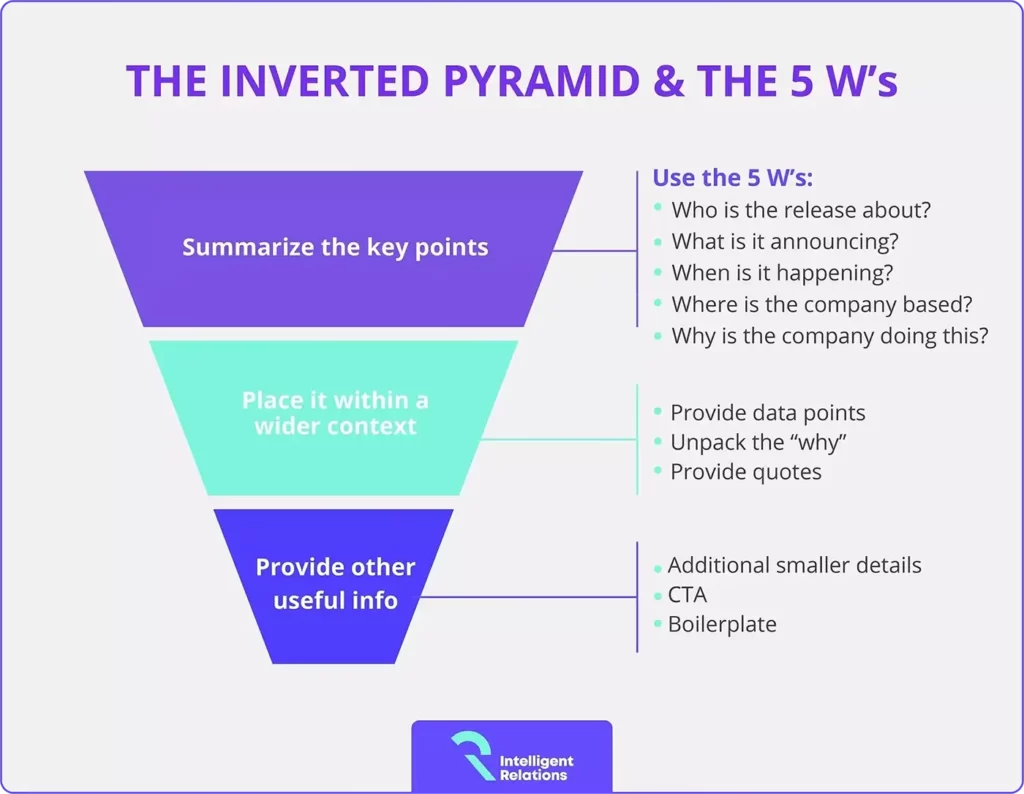
Here’s an example of the 5 W’s in action:
Those Coffee People [WHO] today announces [WHEN] the launch of its new online matching and ordering platform for Colombian direct trade specialty green coffee [WHAT]. The platform is designed to both showcase the wide variety of specialty coffee origins that are available from small independent growers in Colombia [WHY], as well as make the bulk ordering of green coffee as seamless an experience as possible for international buyers [WHERE].
Here’s an example of a press release first paragraph formatted properly:
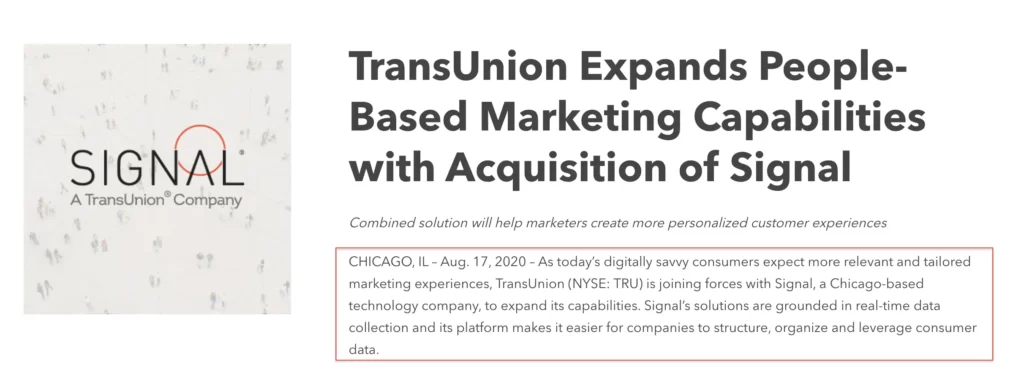
Note that the example puts both the business’s location and date in the first sentence. You can see that TransUnion is based in Chicago and that the date of the release is August 17, 2020. An alternative is to put the date at the top of the release. Some businesses do both.
Pro Tip: Notice the inverted pyramid of information in the infographic. The general idea is to put the most important and exciting information at the top. Fill the body with things the journalist will need to write a compelling article. End with necessary details of lesser importance.
How to Write a Press Release’s Body Paragraphs and Boilerplate
The 5 W’s are half the battle. The other half is making sure that your information is presented in a way that keeps your readers invested.
The rest of your press release is the meat. Here are some things to keep in mind:
- Be honest and unbiased while praising your company.
- Use neutral language that doesn’t sound like sales or marketing speak.
- Use the third person when talking about you and your company.
- Steer clear of industry jargon with the general public in mind.
- Write at a level that’s easy to read for your target audience.
- Use sources, data, and direct quotes where relevant.
- Consider writing the release in the style of a news article.
- Keep it short – aim for one page.
Here’s an infographic for easy reference:
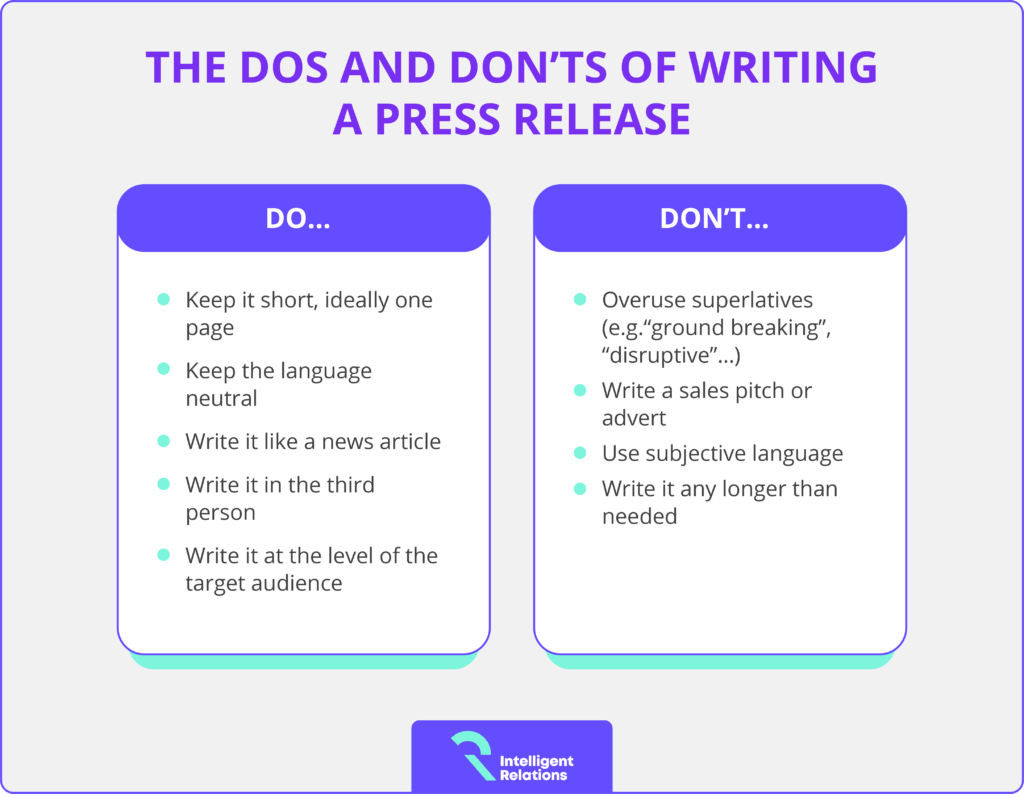
Once you’ve nailed tone and language, focus on adding data and quotes. Adding these types of resources proves your authority and credibility on the topic you’re presenting.
Let’s look at the full Those Coffee People press release for their new business:
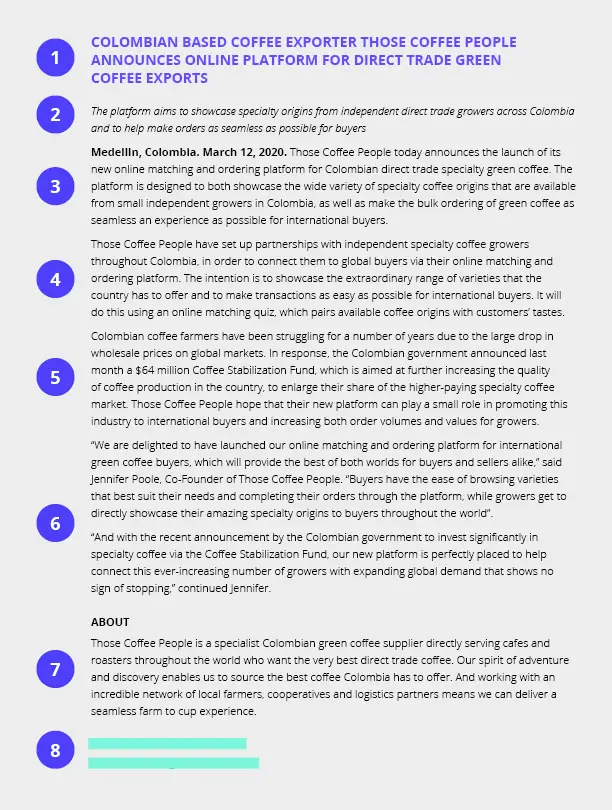
You can see that they’ve added data about the Colombian government announcing a $64 million Coffee Stabilization Fund aimed at helping struggling Colombia coffee farmers.
That bit of data ties in a current social issue with the platform launch, making the announcement more relevant and part of a broader conversation.
Also note that the press release includes two direct quotes from Those Coffee People’s Co-founder, Jennifer Poole. She also mentions the new government initiative, tying everything together in a usable quote. When considering how to write a press release, remember to plan quotes to enhance the content.
The example also shows good usage of the following:
- Headline (Clear, Newsworthy Topic)
- Subtitle
- The 5 W’s
- Placement of Company Location
- Boilerplate
Which brings us to how to write press release’s ending.
You should sum up your press release with a boilerplate. A boilerplate is like a business card, giving an overview of who you are and what your business does. It looks like this:

Pro Tip: Adding direct quotes strengthens the validity of your press release. Journalists love first-person quotes to feature in their stories. Go to the people involved and ask for quotes related to the announcement. You can always clean them up and edit them to perfection.
Not sure how to write a press release boilerplate? We’ve got you covered! Check out our guide: Step-by-step Guide to the Press Release Boilerplate
Before You Send – Checklist for a Successful Press Release
Now that you know how to write a press release, it’s time to write and send it!
But before you send your press release, there are a few other things you should prepare. You’ll also want to go back over what you’ve written to look for angles you might have missed.
Here’s a list of things you should consider:
- Newsworthiness
Double check your press release to make sure it sounds newsworthy and airtight.
Ask yourself:
- Is this newsworthy?
- Would the general public care about this announcement?
- Would journalists find the announcement interesting?
- If I send this to journalists, will they be excited to write about it?
- Is the announcement important in a larger context?
At this point it’s also a good idea to go back over grammar, spelling, and style. You want to make sure that your content is concise and non-promotional. Again, keep it at an easy reading level. And be sure to use bullet points, bold, and italics to highlight important information.
- Newsjacking
Let’s go back to that last point under newsworthiness. Is your announcement important within a larger context? Not sure? Then you might want to consider newsjacking.
Newsjacking is a little different than showing how your announcement ties into a current trend or social issue. Instead it’s the act of piggybacking off a current news story or event that is relevant to yours. Here are some examples:
- Covid
- Elections
- New Government Initiatives
- New Regulations
- Crypto Winter
It might take some extra work to find the right news item. You might also find that a tie in is obvious right away. Just don’t force it.
- Multimedia Usage
After you’ve edited, look back over what you’ve written once again.
Is there any missed opportunity to add multimedia? What would that look like?
Consider adding things like:
- Images
- Video
- Infographics
- Diagrams
- Data Charts
- Your Logo
- Headshots for Quotes
- Product Screenshots
- Website Screenshots
Giving journalists visuals to work with gives them more content for their articles. It also gives you a chance to show off branded content that people can reprint and share. Just make sure that whatever you include is on brand and on topic.
Pro Tip: Yes, multimedia content can help you stand out. But you want to make sure it doesn’t detract from your message. Don’t overwhelm your body text with added media. Plus, most press release distribution services charge for adding media and don’t always support or accept what you want to include. So, check the platform you’re using before adding any content of this sort.
- Target Audience
Who would be most interested in your news item? Would you benefit from reaching people in a specific location, industry, or product market?
If so, make a list of specific journalists who are a good fit for your news. Don’t just blast your press release to generalists with bylines at top news outlets. Identify your audience and curate a list of journalists who write just for them.
Examples of curated journalist lists include:
- Food Journalists
- Sports Journalists
- Fintech Journalists
- Marketing Journalists
- Music Journalists
- Travel Journalists
- NFT Journalists
- Gaming Journalists
Just to list a few. You can also make lists of publications or magazines where you’d like to publish. Once you’ve done that, you just choose the journalist who writes for them on your topic.
Pro Tip: If you want to get really fancy, be sure to track your campaign. The simplest way is to note who got the email, who opened the email, and who published. Keeping a spreadsheet of those who showed interest allows you to build important relationships.
- Press Distribution Services
You might also want to consider using a news distribution service. That’s especially true if your news has general appeal. For example, you’ve hired a new CEO or received an industry award.
Have a list on hand so that you’re ready to go. Here are a few popular services you can use:
A note on using a press distribution service versus a curated list of target journalists:
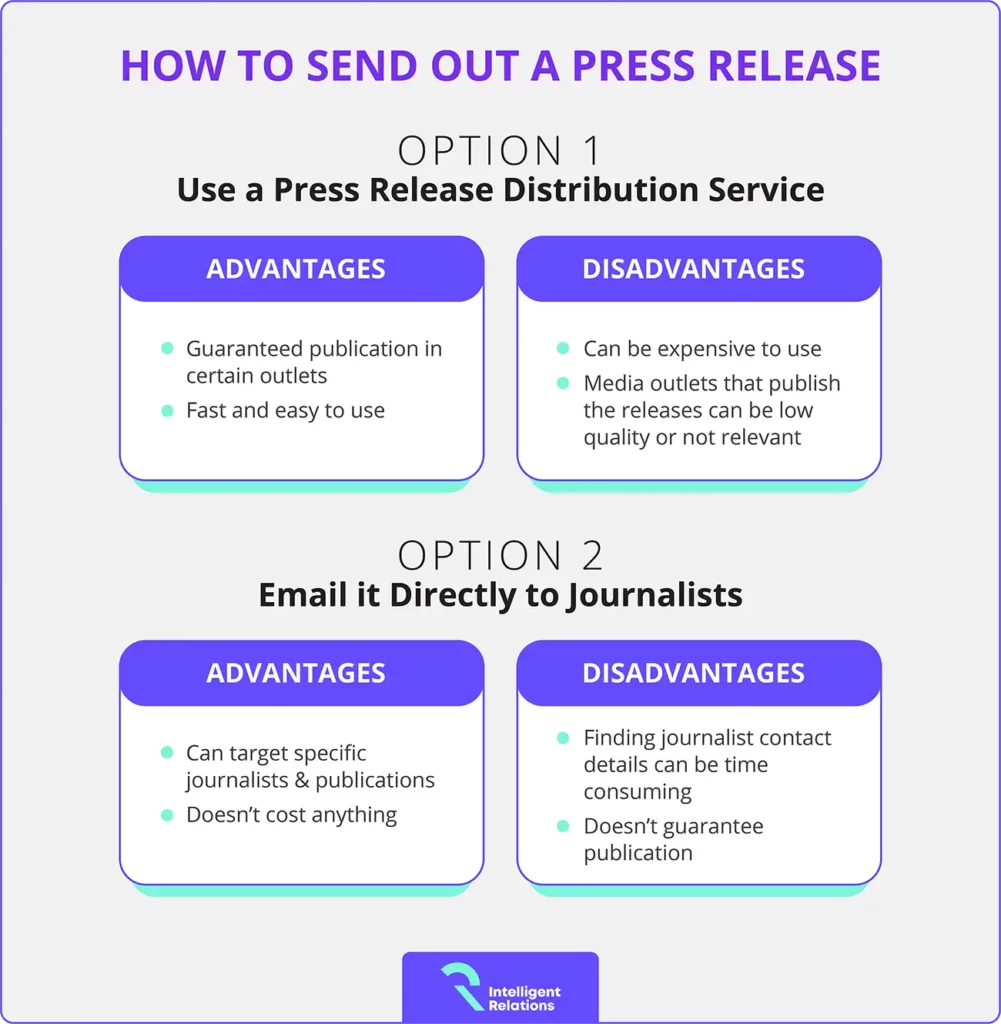
When choosing between a press release distribution service and emailing a list of journalists there are some important factors to consider.
First, putting out a press release on a distribution service can get you auto-republished articles on the back pages of some legitimate publications. Depending on which service you choose you could get on Yahoo! or Business Insider among others.
While these may go to a press graveyard where no one sees them, you can still say you’ve been published on these sites. And that’s great for your reputation.
At the same time, it’s worth it to create lists of targeted journalists when you have an announcement that fits into a broader context. For example, you’re opening a new brand of your business in Arizona. Then you’d want to target both localized Arizona newspapers and press release distribution services.
Or let’s say you’re making an announcement targeted at a specific market niche – e.g., the launch of a new fintech product. Sending a press release to a curated list of top fintech journalists gives you a more direct line to your target audience.
Not satisfied with our shortlist of distribution services? Check out our complete list of free press release distribution services here: The Best Free Press Release Distribution Services
- Release Time
If you are going to use a press release distribution service, don’t publish on the hour.
Why?
Because everyone else is doing it. So, instead of publishing your press release at 9:00 A.M. on the dot, do it at 9:05 A.M. It’s a simple way to set yourself apart in the slush pile.
Want to know which day is best for sending press releases? Want to know the exact time to submit? Check out our article: A Quick Guide to Press Release Submission Timing
- Press Embargos
Consider sending your press release under embargo a few days before you want it to go live. That gives journalists time to figure out what they are going to write before the news goes stale.
What is a press release embargo? It’s when you choose to write “Hold Release Until [Date]” instead of “For Immediate Release” at the top of your press release.
What are the benefits of an embargoed press release? Still not 100% sure what it is? Check out our article: Reap the Benefits of an Embargoed Press Release
- Share on Social Media
Yes, sharing on social media is something you’ll do AFTER you send your press release. But you can start prepping before. It’s important to share, reshare, retweet, and repost any coverage you get on your own social media channels.
That’s because you want to make sure that you are getting a cut of the traffic. So, anything you put out there, route it back to channels you control.
A good way to make sure that happens is to put a strategy and post templates in place prior to launching. That way you can share posts in real time as your story gets picked up by the media.
Pro Tip: Let’s say you get picked up by a prestigious publication. Make sure to add that to your media bar if you have one. Don’t know what that is? It’s a bar that spans your website’s homepage and lists the most important news sites on which you are featured.
- Follow-up Campaigns
Launching a social media campaign after sending your press release is the first step. But it’s not the only campaign you should launch in the aftermath.
Your campaign should START with a press release and CONTINUE with a conversation across various media points. And the perfect time to do follow-up pitches is immediately after release.
What might these pitches look like? Here’s a few ideas:
- CEO Interview Outreach
- Podcast Interviews
- Thought Leadership Pitches to Niche Media
- Pitches on the Ramifications of the Announcement in Broader Context
- Release of Related Research or Data
The real magic happens when you launch a full-bodied campaign aimed at hitting all talking points on all possible channels.
Want to know how to pitch to a podcast in 2024? We’ve got you covered! Check out our article: How to Easily Pitch to Podcasts in 2024 [+Real Examples]
- Consider Hiring a Professional
There’s no shame in bringing in the professionals.
If you’ve gotten this far and are still unsure or feel overwhelmed, consider hiring professionals.
Even if you know what you’re doing, don’t be afraid to call in backup. You may have a news item or full campaign that needs more attention than you can provide.
A professional service can offer hands-on things like outreach under embargo and launching a series of follow-up media campaigns. That’s especially handy when you’re handling a major announcement with lots of moving pieces.
Need to know how to target and pitch journalists for your press release? For a full guide on how to send a press release, check out our article: How to Successfully Submit a Press Release
Final Thoughts
While learning how to write a press release can feel like learning how to write a resume or cover letter, it’s easier than it seems.
Just remember to use the right formatting, add all the details, and make it interesting. PR is a great way to extend your marketing efforts beyond the channels that you control.
And now you have the tools to write a golden ticket of entry.
If you’re still not sure how to write a press release, let us help! Simply book a free consultation with us to get expert insight into how to start or improve your press release.

